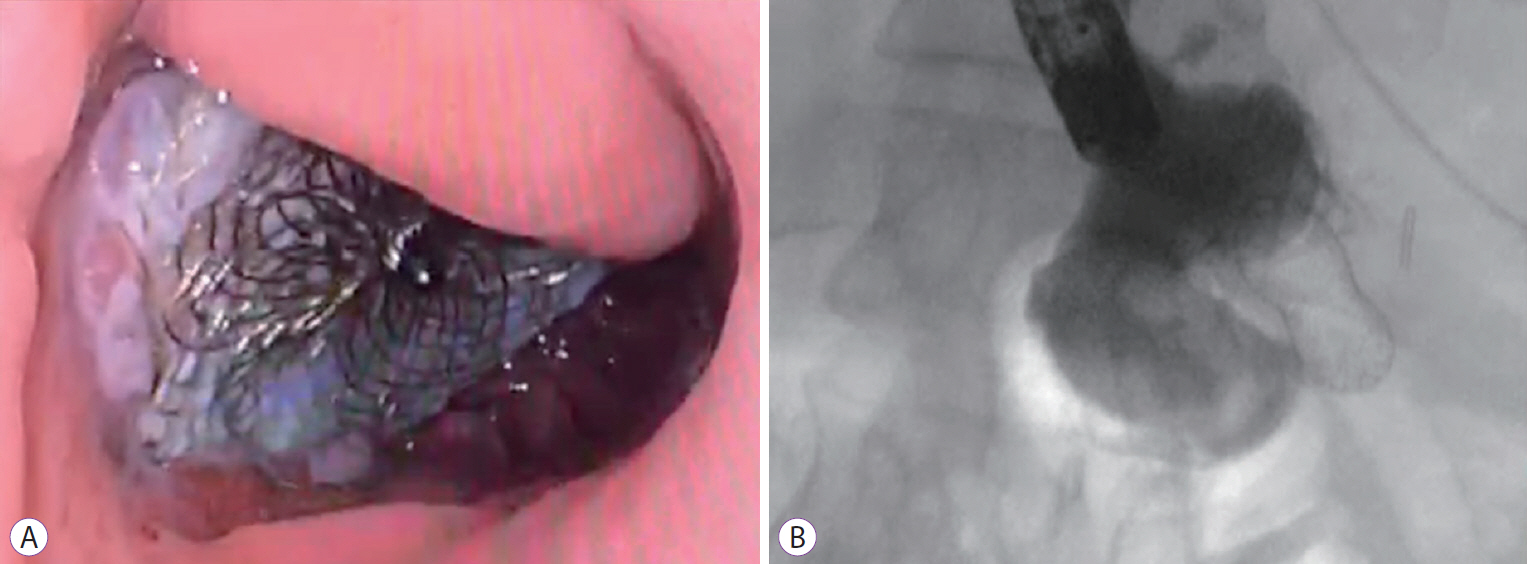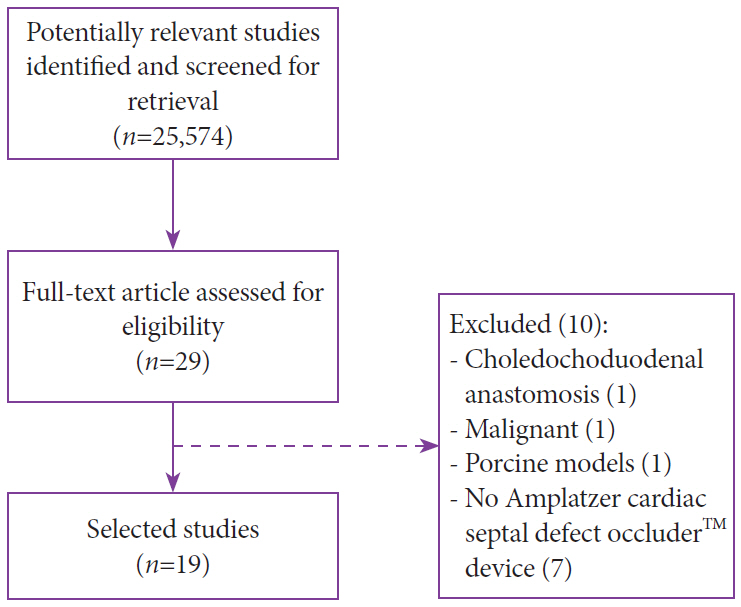Clin Endosc.
2020 Jan;53(1):37-48. 10.5946/ce.2019.030.
Role of Cardiac Septal Occluders in the Treatment of Gastrointestinal Fistulas: A Systematic Review
- Affiliations
-
- 1Brigham and Women’s Hospital, Harvard Medical School, Boston, MA, USA
- 2Hospital das Clínicas da Faculdade de Medicina da Universidade de São Paulo, São Paulo, Brasil
- 3Hospital das Clínicas Caracas, Unidad de Exploraciones Digestivas, Caracas, Venezuela
- KMID: 2500903
- DOI: http://doi.org/10.5946/ce.2019.030
Abstract
- Treating gastrointestinal (GI) fistulas endoscopically is challenging owing to an established epithelial tract. The variety of endoscopic approaches is transforming endoscopy into a first-line therapy. However, many sessions are often required, with variable success rates. Owing to these limitations, the off-label use of cardiac septal occluders (CSOs) has been reported. We searched for articles related to CSOs in the MEDLINE, EMBASE, Cochrane Library, and LILACS databases and gray literature. The primary outcomes included technical success, clinical success, and safety of CSOs in GI fistula management. A total of 25,574 records were identified, and 19 studies ultimately satisfied the inclusion criteria. Technical success was achieved in all cases. Of the 22 fistulas, 77.27% had successful closure, with a mean follow-up period of 32.02 weeks. The adverse event rate was 22.72%, with no associated mortality. Univariable and multivariable regression analyses showed no significant difference in the success of closure and adverse events in relation to several variables among the subgroups. The use of CSOs appeared to be technically feasible, effective, and safe in the treatment of GI fistulas. The satisfactory results derived from this sparse literature suggest that it can be an option in the management of GI fistulas.
Figure
Reference
-
1. Caulfield H, Hyman NH. Anastomotic leak after low anterior resection: a spectrum of clinical entities. JAMA Surg. 2013; 148:177–182.2. de Moura DTH, Sachdev AH, Thompson CC. Endoscopic full-thickness defects and closure techniques. Curr Treat Options Gastroenterol. 2018; 16:386–405.
Article3. Schulman AR, Thompson CC. Complications of bariatric surgery: what you can expect to see in your GI practice. Am J Gastroenterol. 2017; 112:1640–1655.
Article4. Haito-Chavez Y, Kumbhari V, Ngamruengphong S, et al. Septotomy: an adjunct endoscopic treatment for post-sleeve gastrectomy fistulas. Gastrointest Endosc. 2016; 83:456–457.
Article5. Haito-Chavez Y, Law JK, Kratt T, et al. International multicenter experience with an over-the-scope clipping device for endoscopic management of GI defects (with video). Gastrointest Endosc. 2014; 80:610–622.
Article6. Melmed GY, Kar S, Geft I, Lo SK. A new method for endoscopic closure of gastrocolonic fistula: novel application of a cardiac septal defect closure device (with video). Gastrointest Endosc. 2009; 70:542–545.
Article7. Lee HJ, Jung ES, Park MS, et al. Closure of a gastrotracheal fistula using a cardiac septal occluder device. Endoscopy. 2011; 43 Suppl 2 UCTN:E53–E54.
Article8. Coppola F, Boccuzzi G, Rossi G, Gaia S, Cosimato M, Recchia S. Cardiac septal umbrella for closure of a tracheoesophageal fistula. Endoscopy. 2010; 42 Suppl 2:E318–E319.
Article9. Kantsevoy SV, Bitner M, Hajiyeva G, et al. Endoscopic management of colonic perforations: clips versus suturing closure (with videos). Gastrointest Endosc. 2016; 84:487–493.
Article10. Kantsevoy SV, Bitner M, Davis JM, Hajiyeva G, Thuluvath PJ, Gushchin V. Endoscopic suturing closure of large iatrogenic colonic perforation. Gastrointest Endosc. 2015; 82:754–755.
Article11. Lippert E, Klebl FH, Schweller F, et al. Fibrin glue in the endoscopic treatment of fistulae and anastomotic leakages of the gastrointestinal tract. Int J Colorectal Dis. 2011; 26:303–311.
Article12. Mukewar S, Kumar N, Catalano M, et al. Safety and efficacy of fistula closure by endoscopic suturing: a multi-center study. Endoscopy. 2016; 48:1023–1028.
Article13. de Moura DTH, Brunaldi VO, Minata M, Riccioppo D, Santo MA, de Moura EGH. Endoscopic vacuum therapy for a large esophageal perforation after bariatric stent placement. VideoGIE. 2018; 3:346–348.
Article14. de Moura EG, Silva GL, de Moura ET, et al. Esophageal perforation after epicardial ablation: an endoscopic approach. Endoscopy. 2015; 47 Suppl 1 UCTN:E592–E593.
Article15. Okazaki O, Bernardo WM, Brunaldi VO, et al. Efficacy and safety of stents in the treatment of fistula after bariatric surgery: a systematic review and meta-analysis. Obes Surg. 2018; 28:1788–1796.
Article16. Boulougouri K, Theodoropoulos E, Karydas G, Tachtaras E, Hatzinikolaou A, Georgountzos V. Combined endoscopic and percutaneous treatment of a duodenocutaneous fistula using an Amplatzer septal occluder. Cardiovasc Intervent Radiol. 2009; 32:356–360.
Article17. Uthaman B, Al-Qbandi M, Abushaban L, Rathinasamy J. Transcatheter closure of large pulmonary arteriovenous fistula including pulmonary artery to left atrial fistula with Amplatzer septal occluder. Catheter Cardiovasc Interv. 2007; 70:422–428.
Article18. Jolly N, Garg RK, Raman J, Hijazi ZM. Amplatzer septal occluder device for closure of aortic pseudoaneurysms. Catheter Cardiovasc Interv. 2007; 70:619–620. author reply 621.
Article19. Gómez López A, García Luján R, De Pablo Gafas A, et al. First use of Amplatzer device for bronchopleural fistula after lung transplantation. Thorax. 2017; 72:668–670.
Article20. Moher D, Liberati A, Tetzlaff J, Altman DG. Preferred reporting items for systematic reviews and meta-analyses: the PRISMA statement. Ann Intern Med. 2009; 151:264–269. W64.
Article21. Rabenstein T, Boosfeld C, Henrich R, Ell C. First use of ventricular septal defect occlusion device for endoscopic closure of an esophagorespiratory fistula using bronchoscopy and esophagoscopy. Chest. 2006; 130:906–909.
Article22. Green DA, Moskowitz WB, Shepherd RW. Closure of a broncho-neo-esophageal fistula using an amplatzer® septal occluder device. Chest. 2008; 134(4 Suppl 2):23C.
Article23. Kouklakis G, Zezos P, Liratzopoulos N, et al. Billroth II gastrectomy complicated by gastrojejunocolonic fistulas, treated endoscopically with a cardiac septal defect closure device. Endoscopy. 2010; 42 Suppl 2:E134–E135.
Article24. Baron TH. Endoscopic closure of a gastrocolonic fistula using a cardiac ventricular septal defect occlusion device. Gastrointest Endosc. 2010; 71:AB104.25. Repici A, Presbitero P, Carlino A, et al. First human case of esophagus-tracheal fistula closure by using a cardiac septal occluder (with video). Gastrointest Endosc. 2010; 71:867–869.
Article26. Cardoso E, Silva RA, Moreira-Dias L. Use of cardiac septal occluder device on upper GI anastomotic dehiscences: a new endoscopic approach (with video). Gastrointest Endosc. 2012; 76:1255–1258.
Article27. Kadlec J, Turner K, Van Leuven M. Attempted closure of a post-pneumonectomy oesophagopleural fistula with an Amplatzer atrial septal occluder. Interact Cardiovasc Thorac Surg. 2013; 16:538–540.
Article28. Kumbhari V, Storm AC, Saxena P, Okolo PI 3rd. Closure of a persistent gastric leak using a cardiac septal occluder. Endoscopy. 2014; 46 Suppl 1 UCTN:E147–E148.
Article29. Kumbhari V, Azola A, Okolo PI 3rd, et al. Closure of a chronic tracheoesophageal fistula by use of a cardiac septal occluder. Gastrointest Endosc. 2014; 80:332.
Article30. Wiest R, Tutuian R, Meier B, Nett P. Use of a cardiac occluder for closure of a complex gastric leak after bariatric surgery. Endoscopy. 2014; 46 Suppl 1 UCTN:E487–E488.
Article31. Odemis B, Beyazit Y, Torun S, Kayacetin E. Endoscopic closure of gastrocutaneous fistula with an AMPLATZERTM septal occluder device. Therap Adv Gastroenterol. 2015; 8:239–242.32. Cohen-Atsmoni S, Tamir A, Avni Y, Priel IE, Roth Y. Endoscopic occlusion of tracheoesophageal fistula in ventilated patients using an Amplatzer septal occluder. Indian J Otolaryngol Head Neck Surg. 2015; 67:196–199.
Article33. Subtil JC, Valenti V, Cienfuegos JA, Calabuig J, Hernández-Lizoain JL, Muñoz-Navas M. Successful endoscopic closure of multiple tracheoesophageal fistulas following implantation of two atrial septal defect occluders. Endoscopy. 2016; 48:E346–E347.
Article34. Fernandez-Urien I, Lezaun R, Hernández M, Lainez B, Leitão C, Vila J. Esophagobronchial fistula closed by a cardiac septal occluder device. Endoscopy. 2016; 48 Suppl 1:E289–E290.
Article35. Mejia Perez LK, Confer B, Veniero J, Raymond D, Bhatt A. Closure of a persistent esophagopleural fistula by use of an atrial septal occluder device. VideoGIE. 2016; 1:27–28.36. Willingham FF, Buscaglia JM. Endoscopic management of gastrointestinal leaks and fistulae. Clin Gastroenterol Hepatol. 2015; 13:1714–1721.
Article37. Merrifield BF, Lautz D, Thompson CC. Endoscopic repair of gastric leaks after Roux-en-Y gastric bypass: a less invasive approach. Gastrointest Endosc. 2006; 63:710–714.
Article38. Ribeiro IB, Bernardo WM, Martins BDC, et al. Colonic stent versus emergency surgery as treatment of malignant colonic obstruction in the palliative setting: a systematic review and meta-analysis. Endosc Int Open. 2018; 6:E558–E567.
Article39. Ell C, Boosfeld C, Henrich R, Rabenstein T. Endoscopic treatment of the “sump syndrome” after choledochoduodenostomy: a new technique using an amplatzer septal occluder. Z Gastroenterol. 2006; 44:1231–1235.
Article40. Perretta S, Sereno S, Forgione A, et al. A new method to close the gastrotomy by using a cardiac septal occluder: long-term survival study in a porcine model. Gastrointest Endosc. 2007; 66:809–813.
Article41. Malespin M, Gaspar JP, Boulay B. Palliation of a malignant gastrocolic fistula with the use of an atrial septal defect occlusion device. Endoscopy. 2014; 46 Suppl 1 UCTN:E4.
Article42. Li J, Gao X, Chen J, Lao M, Wang S, Zeng G. Endoscopic closure of acquired oesophagorespiratory fistulas with cardiac septal defect occluders or vascular plugs. Respir Med. 2015; 109:1069–1078.
Article43. Sun M, Pan R, Kong X, Cao D. Successful closure of postoperative esophagobronchial fistula with amplatzer vascular plug. Ann Thorac Surg. 2015; 99:1453.44. Vivacqua A, Malankar D, Idrees JJ, Rice TW, Raymond DP, Roselli EE. Endoscopic repair of recurrent tracheoesophageal fistula with an atrial septal occluder device. Ann Thorac Surg. 2016; 102:e485–e487.
Article45. Young JA, Shimi SM, Alijani A, Patil PV, Bhat R. Occlusion of a neo-esophageal-bronchial fistula using the Amplatzer vascular plug 2. Diagn Interv Radiol. 2013; 19:259–262.
Article46. Koo JH, Park KB, Choo SW, Kim K, Do YS. Embolization of postsurgical esophagopleural fistula with AMPLATZER vascular plug, coils, and Histoacryl glue. J Vasc Interv Radiol. 2010; 21:1905–1910.
Article47. Kılıçkesmez Ö, Andıç C, Oğuzkurt L. Delayed failure of rectovaginal fistula embolization with Amplatzer vascular plug 2. Diagn Interv Radiol. 2014; 20:511–512.
Article48. Rodrigues AJ, Scordamaglio PR, Tedde ML, Minamoto H, de Moura EG, Pedra CA. Bronchoscopic closure of tracheoesophageal fistulas. Gastrointest Endosc. 2011; 74:1173.
Article
- Full Text Links
- Actions
-
Cited
- CITED
-
- Close
- Share
- Similar articles
-
- Comparison of Embolization Coils and Patent Ductus Arteriosus Occluders for Coronary Artery Fistula Transcatheter Closure: A Single Centre Experience
- The prevalence of pouch fistulas in ulcerative colitis following restorative proctocolectomy: a systematic review and meta-analysis
- Complex Coronary Cameral Fistulas Evaluated by Multi-Detector CT Angiography: A Report of Three Rare Cases and a Review of the Literature
- A Case of Aortopulmonary Septal Defect
- Imaging Findings of Coronary Artery Fistula in Children: A Pictorial Review




